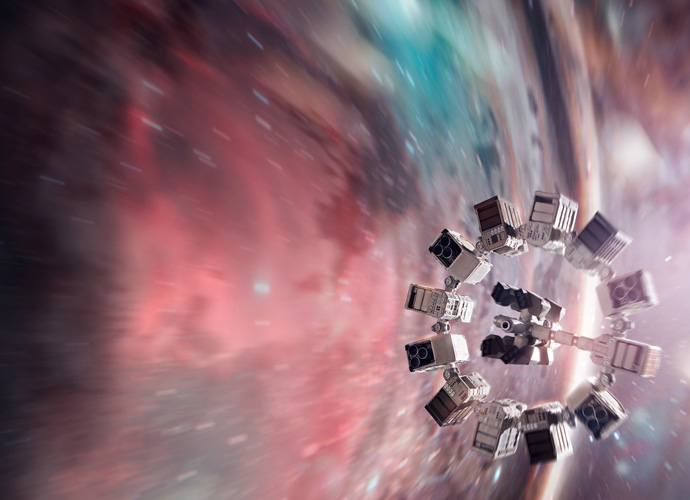Is The Science Of ‘Interstellar’ Right? The Science Fascinates, But The Fiction Doesn’t
Admittedly, I wasn’t the biggest fan of Christopher Nolan’s Interstellar. For an entertainment level, there really isn’t much too it, but from a scientific level there is plenty open for definition and discussion. I’ve broken it down into two parts: The Plot and The Science.
PLOT
There are some fairly obvious holes at the center of the story. Some are nitpicks and some are as deep and dense as Gargantua.
#1 Cooper (Matthew McConaughey) uses the afterburners to evaporate the water in the engines and save him and Amelia Brand (Anne Hathaway) from the second tidal wave. If he was so worried about losing years why didn’t he do this earlier? Did he read the script and notice there needed to be some dramatic tension?
#2 Why load embryos aboard this ships and not have enough people to impregnate?
#3 Even though robots like TARS, CASE and KIPP can’t improvise, sending them on these Lazarus missions would be less dangerous than sending real people out (all of whom have fragile psyches apparently).
#4 Why did we need to hear the Dylan Thomas villanelle that many times?
#5 Humanity was able to save itself by the time Cooper came back. We’re apparently even more technologically advanced. Did no one get the signal Amelia was sending?
#6 How come you can send videos from Earth to the ships, but the ships can only send back data? Is this another one of those “because the plot requires it” sort of things?
#7 Mann is the greatest enemy of man. Too subtle?
#8 If humanity has evolved to a point beyond the physical and is capable of saving their past selves, why not just be clear about it and not just open some wormhole and hope for the best?
#9 Would the wormhole know that Cooper wants to save young and pretty Amelia and not old and craggily Amelia? Can you now suddenly choose how time works? If that’s the case then why not send your past self all of the info you need and keep yourself on Earth and not leave your family?
#10 How did Murph know Cooper and Amelia kinda liked each other? And as a matter of fact, did we get any real indication that they even had feelings for one another? Amelia made a copulation joke, and then after that they seemed to be at odds with each other for the rest of the movie, particularly that “compromised” scene and Amelia revealing she’s still in love with Edmunds.
#11How did Cooper and Murph know that Edmunds didn’t make it?
#12 Father and daughter reunite after decades apart and spend… two minutes speaking to each other.
#13 Radios work inside a tesseract where time is non-linear… we can’t send video messages back to Earth though.
#14 If you can Morse code with your daughter, why only use the word “Stay?” You could send a whole lengthy explanatory message. Sure it would take time to do and for the young versions of you and your daughter to work out but you’re in a place where time has no meaning, so, really, come on!
#15 If you exist outside of time, how come you have to stay only on Murph’s lifeline? Why not go further back into your own past and send yourself a message? Why not find a way to communicate with someone even further into the past and keep the planet from becoming awful in the first place? Isn’t that what Marty McFly did?
#16 How does Cooper recognize his books from behind the bookshelf?
#17 Did Murph really need to burn down a cornfield to distract her brother and get to her room?
THE SCIENCE
The Nolan brothers hired Dr. Kip Thorne as science consultant and Executive Producer and had a large impact on the production. That is, he made sure that the way certain things unfolded was actually reasonable. While I do have a fascination with physics—particularly M-Theory—my understanding (particularly of theoretical physics) is quite lay. From what I have read the science of Interstellar is nearly above reproach except for its depiction of wormholes. There is no field research on wormholes—nor have any been observed. They exist only hypothetically, as first theorized by Einstein and Rosen. In theory, a wormhole could act as a speed tunnel (think warp drive in Star Trek). It’s established in Interstellar (and reality) that it would take two years under conventional engines to make it from Earth to Saturn. Let’s say that the opening of the tunnel is just outside of Earth’s orbit and is stable for travel. If the other end of that tunnel lets out by Saturn, you can make the trip within seconds.
Now this is all just a series of ifs, and as our understanding of the universe grows the hypotheses about wormholes and space travel will likely change, but that’s the nature of science. We can only admit to knowing that we don’t know everything. To nitpick wormholes in a science fiction movie would be ludicrous, especially since Interstellar is using the theoretical part of theoretical physics, and this is, after all, science fiction; if everyone can forgive Han Solo for thinking a parsec was a measure of time, and we can forgive Star Trek for going to the center of the universe (several times), I think we can forgive Interstellar for taking a leap on wormholes.
David Grinspoon has been somewhat critical of the science of the film, but also defends it staunchly under the idea that, yes, this is largely theory. In an interview with Mother Jones he said, “[A] wormhole is sort of the modern version of warp drive. And, yeah, there are actually solutions to Einstein’s general relativity that produce these structures that have been called wormholes, where the geometry of space-time connects different places that in normal space are very distant in the universe. In theory, you can do that. The problem is, if you actually look at how that might work, it doesn’t really work. You’d end up ripping apart everything that went into the wormhole. It’s not like NASA is actually working on this. It’s a way to have your plot device fit the science.”
Dr. Thorne was able to streamline the heavier and more complicated hard science at the core of Interstellar, but there is a lot going on in the film with a runtime just under three hours. It’s not uncommon to get lost. Repeated viewings make it clearer, but if you don’t want to spend the money and time (damn gravity) there’s always Dr. Neil deGrasse Tyson to do the heavy lifting. Earlier this year he praised and took apart what made sense and what didn’t in Gravity, and he quickly did the same thing for Interstellar. Since there are many facets of physics involved in the story, it can be easy to get lost in the explanations—but these are surprisingly accessible.
The science of Interstellar fascinates, but the fiction simply doesn’t. Often it’s more sterile than the science itself. What’s exciting is the questions it raises about further travel into space and the possibilities of the future of humanity. By delving so deep into Einstein’s Relativity we can see that long-term travel is not without its own sacrifices and wrought with dangers from both within and without. The character conflict writes itself, but we only get peeks at the depth of desperation and instability that Mann (Matt Damon) and Romilly (David Gyasi) clearly were battling or the emotional toll of distance on families that Cooper/Murph and the Brands represented but never had the necessary screen time to do anything more than basely establish. In truth, the documentaries posted within this article are more absorbing than Interstellar and contain about as much character development as the film anyway.
RELATED ARTICLES
Get the most-revealing celebrity conversations with the uInterview podcast!






Leave a comment